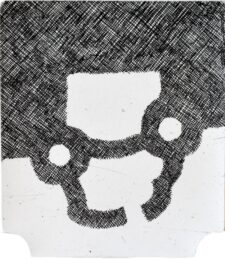

1924-2002
Eduardo Chillida was a Spanish sculptor who created many prominent works. He focused on making abstract sculptures and was influenced by his time spent studying architecture at the University of Madrid in the 1940s. Rather than finish his degree, Chillida headed for Paris and began taking art lessons. He then started working on a series of busts and torsos, focusing on the human form, before developing his hallmark style of creating large, monumental pieces in the abstract style.
Many of Chillida’s works are sculptures displayed for the public, such as the piece “Berlin”, which debuted in 2000 and was commissioned by the German government. Chillida was also the creator of the doors which adorn the basilica of Arantzazu, the steel sculptures at Unesco’s Paris headquarters, the pillar sculpture in front of the Meyerson Symphony Center in Dallas, Texas, and the courtyard which decorates the World Bank offices in Washington, D.C. Part of the enduring legacy of Eduardo Chillida is the Chillida Leku, an outdoor sculpture garden which features his art. After his time in Paris he returned to Spain and lived in San Sebastian, his home town, for the rest of his days. He died in 2002 aged 78.